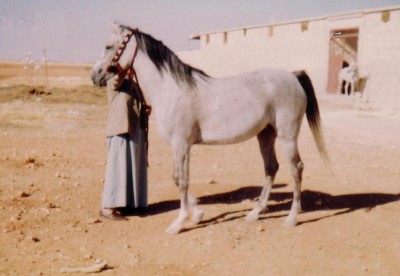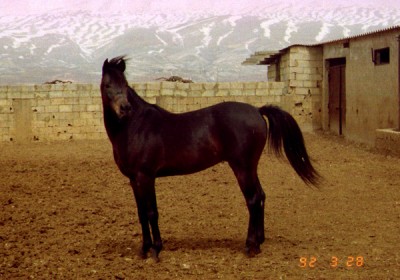Mahrous, desert bred Ubayyan and herd sire at Jabri Arabian, Syria
The ‘Ubayyan Suhayli stallion Mahrous was, until his death in the late 1990s, the herd sire at Mustafa al-Jabri’s stud in Aleppo, Syria. Today his sire line is, along with that of the Damascus stallion Ayid, the most prolific in modern Syrian Arabian horse breeding.
If you check Mahrous’ entry in the Syrian Arabian Horse Studbook, you will find relatively little information about him, in comparison with other major stallions of his generation (e.g, Mobarak, Mashuj, Raad, Marzuq, Mokhtar, all born between 1982 and 1987). I was able to learn more about Mahrus’ background by asking a number of persons, including Mustafa, Radwan Shabariq and the late Abd al-Qadir al-Hammami, as well as others who knew the horse well. Hazaim al-Wair has also conducted a masterful inquiry among the Shammar Bedouins clans of al-Sbeih and al-Ghishm about Mahrous’ sire.
Mahrous was born in 1981, in the steppe area between the rivers Tigris and Euphrates, in Northeastern Syria. He was bred by a Bedouin of the Faddaghah clan of the Shammar tribe, a man named Wuhayyid al-Hamad al-Duhayyim. Wuhayyid then sold Mahrous to horse merchant, who sold him to another, before Mustafa bought him as a young stallion in 1983/84. The photo of Mahrous, above, was taken at al-Jabri stud at about that time, and shows old Abd al-Qadir al-Hammami handling him.

Mahrous’ dam, the fleebitten ‘Adlah, was a famous mare in the Syrian desert, where she was simply known as “the mare of Wuhayyid”, but Wuhayyid was not her breeder. ‘Adlah was bred in 1967 by ‘Awwad al-‘Azzam al-Sahlan (alt. spelling al-Suhayli) of the Faddaghah clan, none other but the owner of the marbat of ‘Ubayyan Suhayli. This strain of ‘Ubayyan Suhayli is actually a branch of ‘Ubayyan Sharrak, which the Shammar Bedouins took in war in an epic episode with the Sharif of Mecca, at least two hundred years ago. ‘Adlah was sold by al-Sahlan to Wuhayyid as a younger mare.
‘Adlah was the daughter of the bay Saqlawi Marzaqani (a marbat that is a branch of the precious strain of Saqlawi Nijm al-Subh, or “Star of the Morning”) stallion of Munayyis al-Saadi of the Shammar (later owned by another man called Ibrahim al-Kurdi. That Saqlawi stallion was also known as “Abu Kitf”, or “Father of the Shoulder”, because of his broken shoulder . “Abu Kitf” was long dead by the time the Syrian Arabian Studbook was compiled, and as such he does not appear in the Volume 1 of the Studbook by name. That said, “Abu Kitf” is arguably the single most dominant influence in this Studbook, through being the maternal grandsire of the three stallions Mahrous, al-Aawar, and the Kuhaylan al-Nawwaq sire of the important mares Hallah (dam of the stallion Basil) and Halah. Abu Kift is also the great-grandsire of the stallion Mobarak, and his blood runs in the veins of numerous other stallions and mares, often ‘hidden’ in the back of the Syrian pedigrees, which only document up to three generations, sometimes four, seldom more.. Perhaps the most influential desert-bred stallion of the 1950s and 1960s, “Abu Kitf” should be the subject of an entry of his own, which I will write at some point, and the Saqlawi Marzaqani strain will be covered in a separate feature, too. So much to write about, so little time!
‘Adlah’s dam was a mare in the marbat of Awwad al-‘Azzam al-Sahlan. She was sired by a Dahman ‘Amer stallion of the horses of Sfug ibn ‘Ajil al-Yawer al-Jarba (al-‘Ajil was mispelled al-Jumaili in the entry of Mahrous in the Syrian Studbook). The father of Sfug al-Yawer, ‘Ajil al-Yawer was the leader of the Shammar of Iraq, and a powerful force in Iraqi politics in the 1940s and 1950s. As such, the story has it that he was the only Iraqi Bedouin leader invited to attend the coronation ceremony of Queen Elizabeth II of Great Britain in 1952. The Dahman ‘Amer marbat of ‘Ajil al-Yawer came from the Barazi family of the city of Hama in Western Syria in the 1930s, and is closely related to the marbat of Jar Allah ibn Tuwayrish of the Sba’ah Bedouins, which supplied the Tahawi Arabs of Egypt with some of their foundation stallions in the 1910s.
In the mid 1980s (so after she had produced Mahrous), Wuhayyid al-Hamad sold ‘Adlah to the consul of the State of Qatar in Damascus, the late Yusuf al-Rumaihi, a man of genuine passion for the horse of the desert, and the owner of the nicest herd of desert Arabian mares, most of which was brought to Qatar and dispersed after his death — a real blunder. At the Rumaihi stud, ‘Adlah produced the stallion Hajees (photo below, which I took in Lebanon in 1992 at the farm of Sayyid Husayn Nasir), by the Egyptian stallion Okaz (Wahag x Nazeemah).
The sire of Mahrous was a dark grey Kuhaylan al-Wati stallion, owned by Diyab al-Sbeih of the Shammar Bedouins, and bred in 1974 or 1975 by the sons of Hakim al-Ghishm, who was the owner of the marbat in the Shammar. That stallion appears without recorded sire in the Syrian Arabian Horse Studbook, but a detailed telephone inquiry conducted by Hazaim al-Wair in 2006 showed that he was also sired by a Kuhaylan al-Wati, that Diab al-Sbeih’s daughter had married a son of Hakim al-Ghishm, that the Kuhaylan al-Wati young stallion had passed to al-Ghihsm on this occasion along with the stallion’s dam, and that the Ghishm clan almost always bred their Kuhaylat al-Wati mares to stallions of their own strain. That Kuhaylan al-Wati stallion was also the sire of the mares al-‘Efrieh (dam of the stallion *Ta’an, imported to the USA), al-Semrieh, and Tairah, the last two being from the prized collection of Basil Jadaan in Damascus. In the Studbook, the discrepancies in the pedigrees of the sires of these mares are the result of clerical transcription errors. All are the daughters of the same stallion, who was the only Kuhaylan al-Wati stallion Diab al-Sbeih ever owned, and this horse is also the sire of Mahrous.


I have not seen Mahrous , but I used his son , Kassar ( Kuhaylan Jreshe ) , and some of my best horses are by him , Hisham Al-Andalus (stallion , champion of Syrian national show four times ) and Baghdad Al-Andalus ( mare , reserve champion of Syrian National show twice ) .
Kindest regards
ANBARGI
I remember seeing Kassar at Mustafa, and I was very impressed with him. Now is his dam Dawhah? Because I remember Mustafa had two Kuhaylat al-Wati mares, one chestnut and one grey, both from al-Ghishm, but from two different branches. The Kuhaylan al-Wati sire of Mahrous was closely related to one of them, either her brother or her maternal uncle, but I don’t remember to which one of the two he was closely related.
Omar, I checked: Kassar’s dam Dawhah (the chestnut) is closely related to the Kuhaylan al-Wati stallion sire of Mahrous.
it is true , his dam is Dawha , one of the best mars i have seen in my life